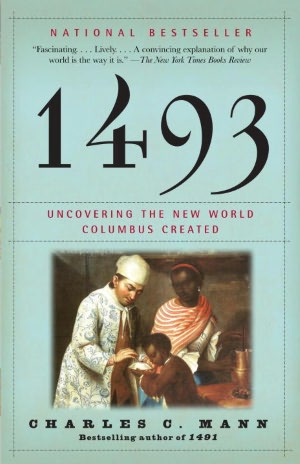Chapter 6 of 1493: Uncovering the New World Columbus Created (by Charles C. Mann) deals with the American origins of modern agriculture -- the combination of improved crops and crop varieties, fertilizer and pesticides.
An Exchange Crop -- The Potato
Mann describes the well known (at least to those with Irish heritage) story of the introduction of the potato to Europe. The potato was domesticated in the Andes and was a mainstay of the Incas. It was relatively quickly introduced to Europe.
Potatoes produced many more calories per acre than did grain crops, and could be grown in places not suited for other crops. They was grown all over Europe, and Mann writes that potatoes more or less eliminated famine from the countries were they were grown (at least for some time). With increased food availability and famine eliminated, populations grew, nowhere more than in Ireland where the landless poor latched on to the crop as a literal life saver.
I would note that there are many crops domesticated in the Andes, only some of which triggered large scale agricultural development outside South America. When I managed a USAID grant to the National Academies, they produced a good study on "The Lost Crops of the Incas".
Fertilizer
Plants need nutrients to grow, especially Nitrogen. Some leguminous plants have associated microorganisms that fix nitrogen from the air and make it available to the plant, but most rely on nitrogen that already exists in the soil. When crops are harvested, the nutrients that they have absorbed from the soil goes with them, and eventually the soil can be exhausted. European farmers before Columbus had learned to add dung and night soil to the land, but livestock were scarce. They had also learned to rest the land by leaving a portion fallow, or to rotate crops.
There are islands off the coast of South American that host huge colonies of sea birds. On some of those, dropping had accumulated for millenniums, sometimes forming layers 150 feet thick. Indians had learned to harvest the guano and use it to fertilize the soil. Europeans observed the success of the crops fertilized with the guano. Soon there was an industry providing guano fertilizer to European farmers. When the guano began to run out, nitrates were found in the Chilean desert and became the major source of nitrogen fertilizer for the world. (Germany was denied access to the Chilean nitrates, used in manufacture of munitions as well as fertilizer, during World War I. In response, German chemists developed an industrial process to fix nitrogen from the air, creating a new industrial source for fertilizer.)
Pesticides
In the Andes, where potato culture developed, a very wide variety of potatoes were, and are still grown. I recall the amazement I felt on first visiting the central market in Cuzco, where there seemed to be hundreds of stalls selling potatoes. I realized that what I thought of as a single crop, the people of Cuzco thought of as a wide variety of tubers, each with its own food properties and each requiring different agricultural practices. Those hundreds of stalls were not selling a single product but a vast selection of different products which met the demands of customers sophisticated in the consumption of tubers.
The genetic diversity of tubers grown in the Andes and the traditional farming practices kept pest levels down. The situation was very different in Europe.
When potatoes reached Europe, the genetic diversity that crossed the ocean was very limited. Not all potatoes would grow well under European conditions. As a result, large areas were planted with clones of a single variety. Moreover, when farming practices were "modernized" in Europe they also increased the vulnerability to pests. Thus was created an environment in which plagues of pests increasingly threatened crops by the 19th century. A uniquely propitious environment for the potato blight, another species imported to Europe from the Americas, led to the 1840s potato blight which swept Europe, hitting Ireland most severely. In Ireland alone, it is estimated that a million people died in the famine that ensued and millions more emigrated.
The Colorado potato beetle was another American immigrant to Europe. It too loved the homogeneous fields of potatoes, destroying crops.
Eventually, Europeans found chemical pesticides that were effective against the Colorado potato beetle and even the potato blight. Thus began the ever increasing use of chemical pesticides to control pests that threatened large mono-crops on today's farms.
Final Comment
Today a large and increasing portion of the world is dependent on introduced crops, grown in large farms with the use of industrially produced chemical fertilizers and chemical inputs for pest control. Mann does not consider the other elements of industrial agriculture -- irrigation and mechanization. Nor does he discuss in the chapter the integration of industrial agriculture with industrial society as a whole with specialization and interdependency. Still, this is an interesting insight into the way the world changed in almost imperceptible steps due to the Colombian Exchange.
Previous posts related to 1493:

No comments:
Post a Comment